Chess Automatons*
* much of this information was extracted, often verbatim, from other sites
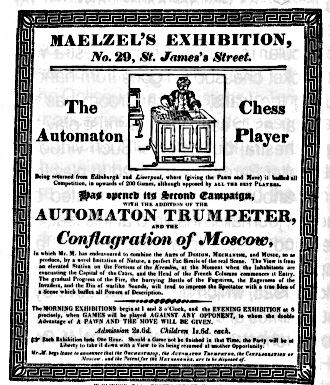 During the 19th century, there were no computers, of course.
During the 19th century, there were no computers, of course.But people were creative enough to imagine such things.
Can a machine be made to talk? Can a machine be made to imitate humans?
Can a machine be made do something as complicated as playing chess??
These people surely had the imagination, but not the technology. But they had other attributes besides imagination. Engineering and craftsmanship was in no way inferior that that of today, and in many respects, it was greater.Clockmakers and cabinetmakers had reach a high point in the history of their fields. Clever contraptions and mechanical marvels were in great demand.
People craved entertainment, but lacked the unending supply we know today. Is it any wonder that some people found a way to work around the technological deficiencies and create mystifying mechanical wonders that not only played chess, but defeated almost all challengers!
There were three well known chess machines, known as automatons:
- Mephisto
- Ajeeb
- The Turk
Mephisto
There is little to be found about this automaton. But what information is available is interesting. Oddly, Mephisto is referred to often as the most famous chess automaton. I never found any evidence to support that claim.
| In 1876 Charles Gumpel, a manufacturer of artificial
limbs, built Mephisto. It was operated in another room by electro-mechanical
means. It actually entered a chess tournament in London (Counties Chess Association)
in 1878 and won. Its operator was Isidor Gunsberg*. George MacDonnell, an
Irish master, withdrew from the tournament, refusing to play Mephisto unless
the operator was revealed. In 1879 Mephisto (Gunsberg) went on tour, defeating every male player. However, when playing ladies, it would obtain a winning position, then lose the game, offering to shake hands afterwards. In London in 1883 Mephisto (Gunsberg) beat Mikhail Tchigorin, one of the top players in the world. In 1889 Mephisto was taken to Paris where it was operated by Jean Tabenhaus. It was subsequently dismantled *Gunsburg, Isidor (1854-1930) Began his career as the player inside the chess automaton Mephisto but later, became a chess professional He was the only British player who has ever played a match for the world championship (until Nigel Short) - against Steinitz and lost (+4=9-6) . In match play, he defeated Bird and Blackburne and drew with Chigorin. In 1916 he sued the Evening News for libel when they said that his chess column contained blunders. He won the suit after the British High Court accepted a submission that in chess matters, eight oversights did not make a blunder. |
Ajeeb
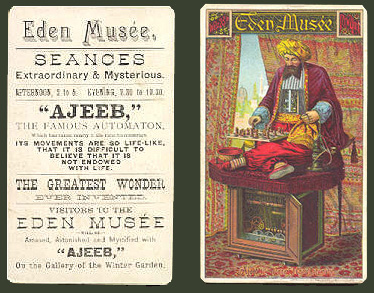 Ajeeb Playing Card (back and front)
Ajeeb Playing Card (back and front)| The strange story of Ajeeb Built by Charles Hopper, a Bristol cabinet maker, in 1865. Ajeeb's countenance was made to match the great departed Turk, whichhad been destroyed in a fire in Philadelphia eleven years prior to Hooper's start on the project, to bring to mind its great success in the world of high society. A life-size figure was operated by many chess and checker players including Constant Ferdinand Burille. He played 900+ games and lost only three times and never lost a checker game. Between 1898 and 1904 it was operated by Pillsbury. In the Edem Museum, New York, it played checkers for a dime and a game of chess for 25 cents. Opponents of Ajeeb included Roosevelt, Houdini, Admiral Dewey, Henry and Sarah Bernhardt and O. Henry. It stood 10 feet in height and was first exhibited at the Royal Polytechnic Institute in Londonin 1868. Between 1868 and 1876 it was on show at the Crystal Palace. 100,000+ people viewed it in Berlin during a three month period. It played at Breslau, Dresden, Leipzig, Hanover, Magdeburg, Cologne, Elbefeld, Dusseldorf, Frankfurt and Wiesbaden. Afterwards it visited Brussels and Paris. Here Zukertort is said to have played against it. Rosenthal played it twice, winning one and losing one. In 1885 Ajeeb visited New York, Minneapolis, Chicago and Kansas City. Charles F. Moehle and Charles Francis Barker, U. S. draughts champion, worked the machine in turn. Sometime in the 1880's, Hooper sold Ajeeb to Jim Smith and retired to England. Smith move his prized automaton to Coney Island. Here the operator was Sam Gotski. During his time Gotski was required by Smith to take on an apprentice to learn the ropes of how Ajeeb worked. In one instance, a sore loser shot Ajeeb in the torso and supposedly wounded its operator. However Gotski, Smith, and several others knew that the apprentice had been killed. To cover up for there still successful automaton, they got rid of the apprentice's body. Due to the hobo/transient nature of the apprentice who was known by no reputable or believable sources, the murder was never discovered. By 1898, Sam was no longer the operator. He left complaining of strange occurrences from inside Ajeeb where the automaton was moving on its own accord. Gotski and Smith remained mutually silent in regard to their crime despite of their separation. Sam then moved into the New York City Dinner Club circuit where he worked behind the scenes for struggling magicians. By 1926, the elderly Sam became friends with stagehand Gustav Burzendt, a distant relative of Kempelens* of Vienna, who had developed a curiosity in Mechanomancy due to the Baron. There friendship was brief. It was cut short when Sam started to suspect that Gustav knew something of the incident. Sam disappeared from New York City, never to be seen again. In that time Ajeeb had gone through two other operators. Both sometime later reported to friends and family brief incidents where Ajeeb seem to acting on its own accord. Allegedly, the last operator refused to play anythingbut checkers due to strange occurrences within the automaton. Gustav Burzendt now fueled with desires to surpass his great uncle, desired to gain Ajeeb. When he couldn't afford to buy it from Coney Island, he began to contemplate its theft. Another operator was Albert Beauregard Hodges (1861-1944). This former U.S. Champion's first job was a hidden operator of Ajeeb, the Chess Automation. He played chess and checkers. He won the US championship in 1894 after defeating Jackson Showalter. He never defended his title. Pillsbury challenged him in 1895 but Hodges declined for business reasons. He was the only American master to play against 5 world chess champions over a period of 60 years. He played Zukertort, Steinitz, Lasker, Capablanca, and Alekhine. He won the Manhattan Chess Club Championship and the New York championship. Pillsbury! One of the greatest natural players ever and the greatest blindfold player of his day operated Ajeeb between 1898 and 1904. His early death is said to have be partly attributed to being cooped up in the small operating area of this machine causing great pain for which he drank heavily to endure. On March l5th, 1926, Ajeeb was allegedly destroyed by a fire on Coney Island. In 1932, two men, Frank Farina and Jesse Henley bought a copy of Ajeeb from a mysterious craftsman named Gus Burns and took it on tour of Canada. Henley was master at checkers and never lost. While on tour they heard rumors that their Ajeeb somehow possessed occult powers. Farina curious investigated the source of these rumors and discovered that it was a confusion concerning another chess playing machine also called Ajeeb which was also touring Canada. This one was not only a chess player but was an astute observer of human nature. Some thought it could tell the future. What Farina discovered no one knows. In the flurry of World War Two, Farina, Henley, and their Ajeeb disappeared from sight. Stories of Ajeeb sightings have proliferated through the dwindling numbers of Clockworkers slowly since these adepts are not very sociable. Naturally many are conflicting but there are several points of consistency. Ajeeb resides somewhere in Ontario and is more than likely being served by the descendants of Burzendt. "A golden means between machine and spirit not fully known" is how most Clockworkers respond to Ajeeb inquiries if at all. If there is a Clockworker who has sought the council of Ajeeb, none will admit to it. It represents their greatest fear: a creation that far outstrips its creator. Perhaps the most interesting episode involving a U.S. President occurred around September 1885, when both the U.S. president and vice-president visitedachess event together! The incident was described as follows in the September1885 issue of The International Chess Magazine: "Ajeeb, 'The Chess Automaton', is now giving exhibitions at Eden Musee, Twenty-third Street, New York. We learn from the Evening Telegram that President Cleveland and Vice-President Hendricks paid a visit recently to Ajeeb's chess room, and the latter had a game with the figure which 'The Automaton' finished with a neat five-move version of the so-called Philidor's Legacy or smothered mate." Unfortunately, we do not know who the hidden player inside Ajeeb was on that occasion, but Albert Hodges, a one-time claimant to the US championship, was one of its secret operators. Sadly, vice-president Hendricks died in office only two months after losing that game. President Cleveland went on in 1888 to become the only president to win the popular vote while losing in the electoral college. He then became the only president to serve two non-consecutive terms when he avenged his 1888 defeat in the 1892 election. The Turk |
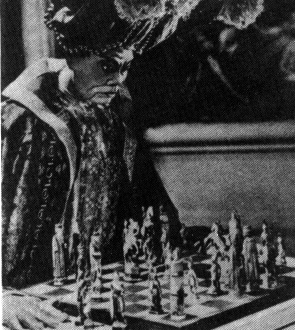 a still from a movie, "The Chess Player", featuring The Turk
a still from a movie, "The Chess Player", featuring The Turk|
During the late 18th and early 19th Centuries,
a chess-playing “machine” toured Europe and America, defeating
almost all comers. The Chess Automaton, better known as “The Turk”,
invented by Baron Wolfgang Von Kempelen. Purporting to be a chess-playing
machine, “The Turk” was actually an ingenious fraud: it was in
reality a contraption designed to allow a hidden human operator to play a
game without seeing the board or touching the pieces. Baron Von Kempelen hired
a succession of chess masters to sit inside “The Turk”,and he
made a fortune displaying the device, despite continual threats of blackmail
by persons who had -- or thought they had -- discovered how the “machine”
operated. Indeed, early in the Automaton’s career, one Freiherr VonRacknitz
published an expose accurately describing a.) how the operator remained hidden
while the Baron opened all the cabinets to assure viewers no one was inside,
and b.) how he could see the moves made by his opponents. Von Racknitz went
so far as to construct his own version, but his design proved less ingenious
than Von Kempelen’s and attracted little notice. In truth, Von Kempelen
was an excellent technician: for example,he devised machines which reproduced
sounds from nature, including the human voice, which were said to have inspired
Alexander Graham Bell to begin work on the telephone. The Automaton was similarly
intricate: although not capable of chess play, “The Turk” was nonetheless
an impressive technical achievement for that time and place.
Von Kempelen sold his creation to a musician/inventor/showman named Johann Maelzel, who revived the Automaton’s career. Napoleon was among the many luminaries who contested a game with the Automaton during Maelzel’s ownership. Maelzel’s friend and business partner, Ludwig Van Beethoven, might at one time have had a financial interest in “The Turk”. The time of Beethoven’s partnership with the inventor was certainly among the most profitable of the composer’s career, although that probably had more to do with some of Maelzel’s other efforts, like the Panharmonicum -- a machine that essentially simulated an orchestra by playing multiple instruments automatically (Beethoven wrote a “symphony” for thePanharmonicum, to commemorate Wellington’s victory over Napoleon at Waterloo). Butlater, Maelzel fell into financial difficulties as crowds for the Chess Automaton dried up; so, like many debtors of that era, he and “The Turk” (AND the chessplayer operating “The Turk”)emigrated to America. The Automaton was a sensation in the United States, and many articles were written purporting to explain how it worked. Edgar Allen Poe wrote one; but even though he appeared to have heard of Von Racknitz’s correct explanations of the Automaton’s workings, Poe’s “deductions”of how it must operate were entirely mistaken. The author did score one point, though: he correctly identified who was playing the game, basically on the Superman/Clark Kent evidence -- Poe noted that the chessplayer was always around before and after “The Turk”’s games, but never while a game was in progress. “The Turk’s" career came to an end not long afterward :the chess player died of a sudden illness, and Maelzel died shortly thereafter. Stored in a warehouse, the Automaton was destroyed in a fire some years later. But it’s legend did not die quite as easily, and after some 40 years, a new Automaton -- this one called “Ajeeb” -- began making the rounds in the United States and England. “Ajeeb” played checkers as well as chess -- players who were masters of both were easy enough to find in those days, and the quick money to be had tempted some of the best. For a while, the U. S. Chess Champion, Harry Nelson Pillsbury, worked inside “Ajeeb”. The Turk’s story was repeated in many particulars, including threats of exposure and the construction of arrival machine called “Mephisto”. But in time, the novelty wore off and “Ajeeb” went into retirement -- eventually perishing in a fire like its more famous predecessor. 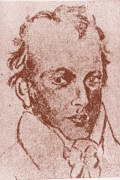 Wolfgang von KempelenCharles Carroll, last surviving signer of the Declaration of Independence, played the Turk at Baltimore in at age 89 and won. William Lewis was a famous nineteenth century chess theoretician and author who can perhaps lay claim to having been the first chess playing robot. He was in fact the player concealed inside the notorious chess playing automaton "The Turk" when it was exhibited in London in 1819. After his chess rooms business went into bankruptcy in 1827 he turned his hand to writing and became very successful. Among his publications were Chessboard Companion, published in 1838. His Series of Progressive Lessons in the Game of Chess is regarded as a landmark in chess literature. He also wrote The Elements of Chess(1882) Fifty Games of Chess(1832) and Chess for Beginners (1835). In addition he translated into English the works of Greco and Stamma. In 1806, Napoleon was the most talked-about man on Earth. His armies had captured a great deal of Europe, and he was on his way to becoming the greatest conquering general (or thug, depending on your point of view) of all time. The Little Corporal fancied himself a strong chess player. As the story is told, Napoleon heard of a chess-playing machine called "The Turk" that was able to beat most, if not all, challengers. Eventually, Napoleon arranged to meet the Turk in Berlin. The "machine" was a strange-looking contraption: a large box with a chessboard on top, and a mannequin dressed up in a gaudy Turkish outfit attached. An opening on the side of the device revealed a complex interior network of pulleys and gears. The French Emperor sat down, and intentionally made an illegal move. The mechanical mannequin shook its head — an "error message" if you will. Napoleon then made another illegal move, and The Turk again shook its head. After several consecutive illegal first moves on by Napoleon, the mechanical chess machine's mannequin violently swept all the pieces off the board. Napoleon laughed; he had played "mess up the chess machine," and won. Afterward, Napoleon did play against the Turk, and lost. (Contrary to what you might have heard, the guy was a lousy chess player.) The Turk, as you may have guessed, contained within its mannequin portion a very talented chess-playing midget — one of several who would keep The Turk a very successful side show attraction for many years to come. Napoleon (w) - Turk (B) 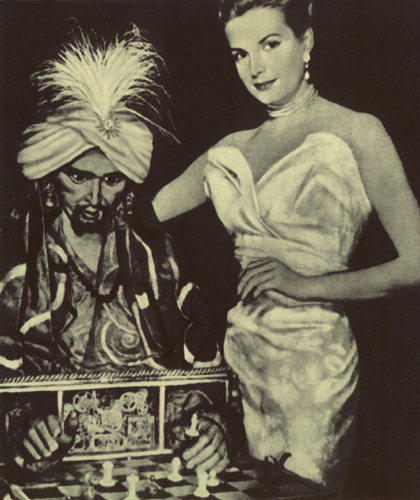 1. e4 e5 2. Qf3 Nc6 3. Bc4 Nf6 4. Ne2 Bc5 5. a3 d6 6. O-O Bg4 7. Qd3 Nh5 8. h3 Bxe2 9. Qxe2 Nf4 10. Qe1 Nd4 11. Bb3 Nxh3+ 12. Kh2 Qh4 13. g3 Nf3+ 14. Kg2 Nxe1+ 15. Rxe1 Qg4 16. d3 Bxf2 17. Rh1 Qxg3+ 18. Kf1 Bd4 19. Ke2 Qg2+ 20. Kd1 Qxh1+ 21. Kd2 Qg2+ 22. Ke1 Ng1 23. Nc3 Bxc3+ 24. bxc3 Qe2# a supposed photograph of the Turk but most likely a replica A slightly different version: During the 1820s and 1830s a Chess Automaton toured the United States, where it became the focus of intense curiosity and speculation. The Automaton was supposedly a complex machine that was able to play chess against a human opponent. The machine was built in the shape of a life-size man who sat in front of a large cabinet that served as a table. The man was made of wood and dressed in Turkish clothes. He was usually referred to as "the Turk." Before the automaton was used, all the doors of the cabinet were opened on opposite sides (one pair at a time), and a candle's light was shined through the cavity, to demonstrate to the audience that no one was hidden inside. The first third of the cabinet was filled with clockwork gears, while the rest was more or less empty. The (human) opponent played on a separate table with a separate board and pieces. A large key was used to wind up the automaton's mechanism before each game. The automaton always played white, thus going first. The operator started the game by reaching inside the small door in the torso of the automaton and flipping a switch. The sound of machinery could be heard each time the automaton moved. Games usually lasted about 30 minutes. The Automaton had originally been built in Europe in 1769 by an inventor known as Baron Kempelen, a nobleman of Presburg in Hungary. He had entertained the court of Empress Maria Theresa in Vienna with it for three years before dismantling it. The Automaton was taken out of storage in 1783, put back together, and brought to London by Johann Nepomuk Maelzel. Eventually it made its way to America. In 1836 an anonymous article appeared in the Southern Literary Messenger. The article, through careful analysis, exposed the Automaton to be an outlandish hoax. The author deduced that there was a man hidden inside the cabinet who was working the machinery, and the author even identified the man by name: William Schlumberger, who was a companion of the showman Maelzel. The anonymous article was written by Edgar Allan Poe. Although he himself perpetrated many hoaxes (the adventures of Hans Pfaall, the great balloon hoax, the facts in the case of M. Valdemar, and Van Kempelen and his discovery), in this case he exposed one. The Automaton was eventually bought at auction by John F. Ohl of Philadelphia and came to rest in the Chinese Museum in Philadelphia. It was destroyed by fire in 1854. 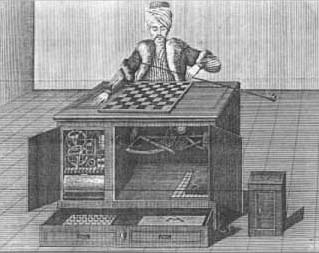 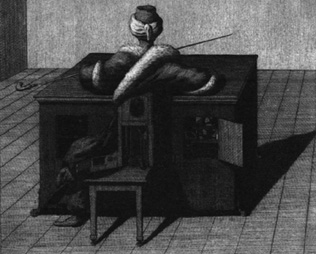 Yet, another version: Johann N. Maelzel was a mechanical engineer who bought the Turk from Wolfgang von Kempelen's son. He supposedly invented the metronome and was a good friend of Beethoven. Prince Eugene de Beauharnais bought the Turk from Maelzel in 1811 for 30,000 francs and Maelzel gave part of the money to Beethoven. In 1817 he bought the Turk back from the Prince for the same sum. No cash was handed over to the Prince, but Maelzel was to pay from any profit he might make. The Prince died but his heirs sued Maelzel for the balance. Maelzel fled to America with the Turk to escape the debts and lawsuits. Maelzel was buried at sea in 1838 after dying on a ship bound from Cuba to America. 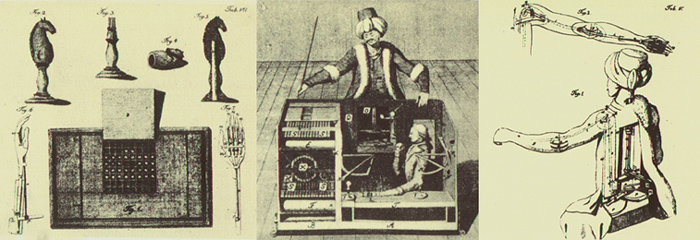 sketches depicting the mechanics of the Turk The Turk was, of course, an elaborate hoax, and its movements were controlled by a concealed operator. This was confirmed by Dr Mitchell, its last owner, who wrote an article about it for the Chess Monthly in 1857. Ironically, given Von Kempelen's desire to upstage the magnetic tricks of a conjuror, it relied on magnets in the chess pieces which set tiny, delicate indicators under each square swinging whenever a piece was picked up or put down. The operator, an expert chess-player hidden in a concealed compartment in the cabinet, followed the action on another chessboard inside the machine, and carried out the Turk's moves using an ingenious mechanical arm that was itself a masterpiece of engineering. References: http://www.rampling.net/kempelen/ http://www.eapoe.org/works/essays/maelzel.htm (Poe's explanation) http://www.geocities.com/siliconvalley/lab/7378/automat.htm http://www.fortunecity.com/underworld/soundcard/1161/Automaton.htm http://courses.ncsu.edu/classes/hi322001/automata.htm http://www.unknownarmies.com/uarchive_item.asp?ID=66 http://www.rampling.net/kempelen/Houdin.htm |